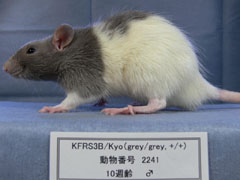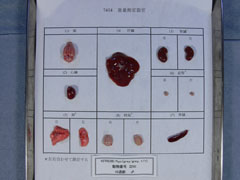| NBRP Rat No: 0571 |
Strain name: KFRS3B/Kyo |
Commmon Name: SRR03-grey,Pearl |
Rat Genome Database |
| Principal Investigator: |
Takashi Kuramoto Graduate School of Medicine, Kyoto University Yoshidakonoe-cho, Sakyo-ku 606-8501 Kyoto Japan |
| Tel: 075-753-4494 Fax: 075-753-4409 |
Email: kuramot@anim.med.kyoto-u.ac.jp |
| Preservation Status: |
Embryo Sperm Living Animals |
 |
 |
| Coat Color |
grey, Pearl (g, Pel) |
| Inbred Generations |
|
| Usage Restrictions |
The recipient of BIOLOGICAL RESOURCE shall obtain a prior written consent on use of it from the DEPOSITOR.
For a commercial use of this resource, a new contract must be concluded between the depositor and the recipient. |
| Genetic Status |
|
| Comercial Availability |
|
|
| Research Category |
|
| Gene Affected |
|
| Origin |
One male rat "SRR-Rocket Science" was introduced from American fancy rat colony (Spoiled Ratten Rattery: SRR, in Kansas City, Missouri) to Kyoto University on July 13, 2005. Inbreeding started from F1 progeny of male "SRR-Rocket Science" and a female PVG/Seac. Homozygous rats for grey mutation were selected for inbreeding. (Sep 25, 2009) |
| Strain characteristics |
This strain carries two mutations grey (g) which causes light grey body color and Pearl (Pel) which causes hair lighter coat color and is lethal in the embryonic period if homozygous. Genetic analyses mapped g to Chr 8 (Kuramoto, 2010). (May 26, 2010) |
| Breeding Conditions |
Maintained by crossing of heterozygous and wild-type for Pearl mutation. This strain is heterozygous for Pearl (segregating strain) and homozygous for grey. Good breeding performance. (Sep 25, 2009) |
| Genotyping |
|
| References |
Yoshihara M, Sato T, Saito D, Ohara O, Kuramoto T, Suyama M.
Application of target capture sequencing of exons and conserved non-coding sequences to 20 inbred rat strains.
Genomics Data. 2016 Dec; 10: 155-157
Kuramoto T, Yokoe M, Yagasaki K, Kawaguchi T, Kumafuji K, Serikawa T.
Genetic analyses of fancy rat-derived mutations.
Exp Anim. 2010;59(2):147-55. |
| Additional strain information |
|
|